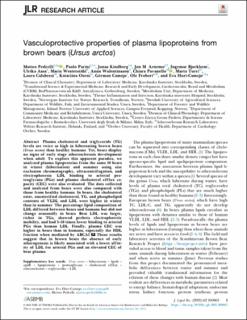Vasculoprotective properties of plasma lipoproteins from brown bears (Ursus arctos)
Pedrelli, Matteo; Parini, Paolo; Kindberg, Jonas; Arnemo, Jon Martin; Björkhem, Ingemar; Aasa, Ulrika; Westerståhl, Maria; Walentinsson, Anna; Pavanello, Chiara; Turri, Marta; Calabresi, Laura; Öörni, Katariina; Camejo, Gérman; Fröbert, Ole; Hurt-Camejo, Eva
Peer reviewed, Journal article
Published version
Permanent lenke
https://hdl.handle.net/11250/2831392Utgivelsesdato
2021Metadata
Vis full innførselSamlinger
Sammendrag
Plasma cholesterol and triglyceride (TG) levels are twice as high in hibernating brown bears (Ursus arctos) than healthy humans. Yet, bears display no signs of early stage atherosclerosis development when adult. To explore this apparent paradox, we analyzed plasma lipoproteins from the same 10 bears in winter (hibernation) and summer using size exclusion chromatography, ultracentrifugation, and electrophoresis. LDL binding to arterial proteoglycans (PGs) and plasma cholesterol efflux capacity (CEC) were also evaluated. The data collected and analyzed from bears were also compared with those from healthy humans. In bears, the cholesterol ester, unesterified cholesterol, TG, and phospholipid contents of VLDL and LDL were higher in winter than in summer. The percentage lipid composition of LDL differed between bears and humans but did not change seasonally in bears. Bear LDL was larger, richer in TGs, showed prebeta electrophoretic mobility, and had 5–10 times lower binding to arterial PGs than human LDL. Finally, plasma CEC was higher in bears than in humans, especially the HDL fraction when mediated by ABCA1. These results suggest that in brown bears the absence of early atherogenesis is likely associated with a lower affinity of LDL for arterial PGs and an elevated CEC of bear plasma.

